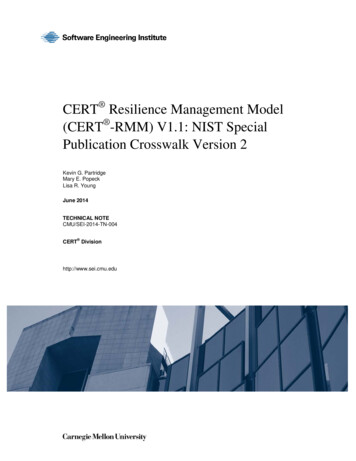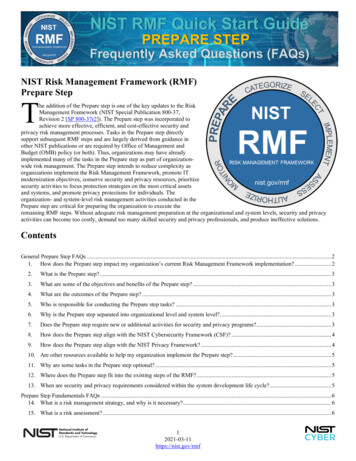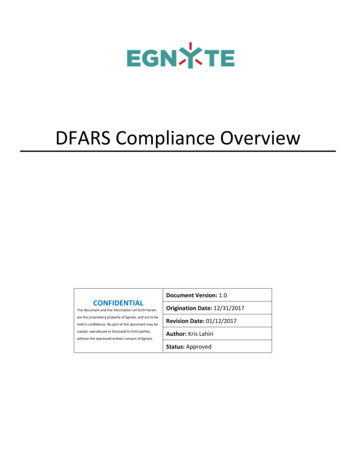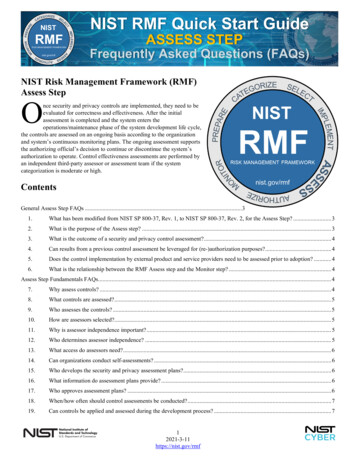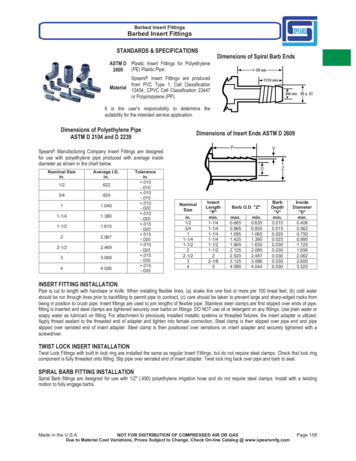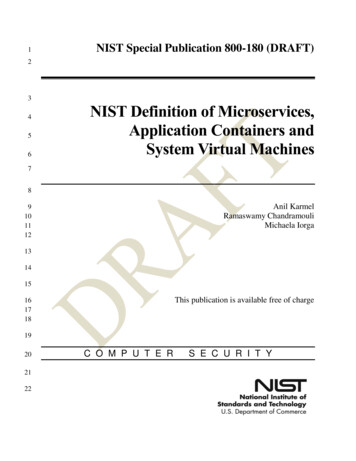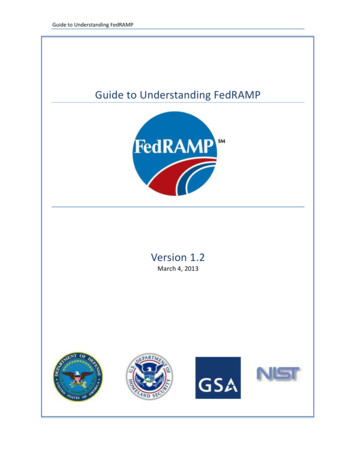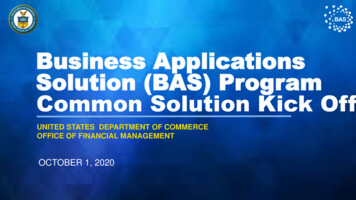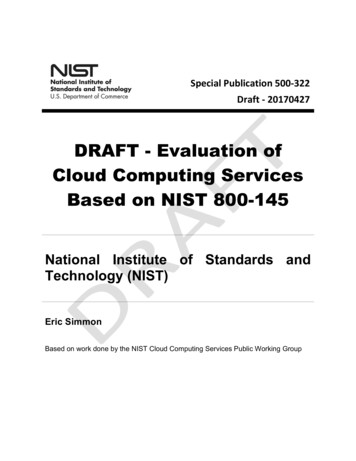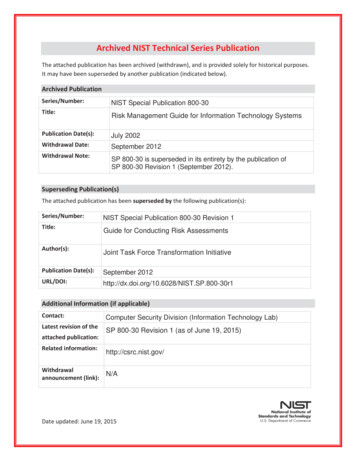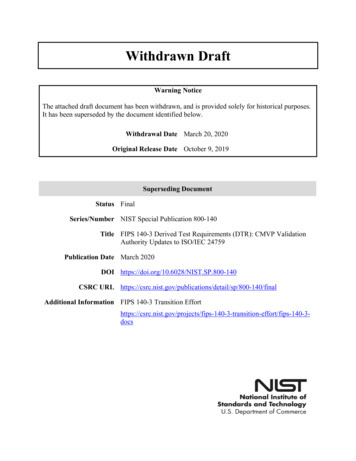
Transcription
Withdrawn DraftWarning NoticeThe attached draft document has been withdrawn, and is provided solely for historical purposes.It has been superseded by the document identified below.Withdrawal Date March 20, 2020Original Release Date October 9, 2019Superseding DocumentStatus FinalSeries/Number NIST Special Publication 800-140Title FIPS 140-3 Derived Test Requirements (DTR): CMVP ValidationAuthority Updates to ISO/IEC 24759Publication Date March 2020DOI https://doi.org/10.6028/NIST.SP.800-140CSRC URL 40/finalAdditional Information FIPS 140-3 Transition ansition-effort/fips-140-3docs
1Draft NIST Special Publication 800-14024FIPS 140-3Derived Test Requirements (DTR):5CMVP Validation Authority Updates to ISO/IEC 2475936Kim Schaffer7891011121314151617I N F O R M A T I O NS E C U R I T Y
18Draft NIST Special Publication 800-1401921FIPS 140-3Derived Test Requirements (DTR):22CMVP Validation Authority Updates to ISO/IEC 445464748Kim SchafferComputer Security DivisionInformation Technology LaboratoryOctober 2019U.S. Department of CommerceWilbur L. Ross, Jr., SecretaryNational Institute of Standards and TechnologyWalter Copan, NIST Director and Under Secretary for Standards and Technology
NIST SP 800-140 (DRAFT)FIPS 140-3 DERIVED TEST REQUIREMENTS49Authority50515253545556This publication has been developed by NIST in accordance with its statutory responsibilities under theFederal Information Security Modernization Act (FISMA) of 2014, 44 U.S.C. § 3551 et seq., Public Law(P.L.) 113-283. NIST is responsible for developing information security standards and guidelines, includingminimum requirements for federal information systems, but such standards and guidelines shall not applyto national security systems without the express approval of appropriate federal officials exercising policyauthority over such systems. This guideline is consistent with the requirements of the Office of Managementand Budget (OMB) Circular A-130.575859606162Nothing in this publication should be taken to contradict the standards and guidelines made mandatory andbinding on federal agencies by the Secretary of Commerce under statutory authority. Nor should theseguidelines be interpreted as altering or superseding the existing authorities of the Secretary of Commerce,Director of the OMB, or any other federal official. This publication may be used by nongovernmentalorganizations on a voluntary basis and is not subject to copyright in the United States. Attribution would,however, be appreciated by NIST.636465National Institute of Standards and Technology Special Publication 800-140Natl. Inst. Stand. Technol. Spec. Publ. 800-140, 16 pages (October 2019)CODEN: NSPUE26667686970717273747576777879Certain commercial entities, equipment, or materials may be identified in this document in order to describe anexperimental procedure or concept adequately. Such identification is not intended to imply recommendation orendorsement by NIST, nor is it intended to imply that the entities, materials, or equipment are necessarily the bestavailable for the purpose.There may be references in this publication to other publications currently under development by NIST in accordancewith its assigned statutory responsibilities. The information in this publication, including concepts and methodologies,may be used by federal agencies even before the completion of such companion publications. Thus, until eachpublication is completed, current requirements, guidelines, and procedures, where they exist, remain operative. Forplanning and transition purposes, federal agencies may wish to closely follow the development of these newpublications by NIST.Organizations are encouraged to review all draft publications during public comment periods and provide feedback toNIST. Many NIST cybersecurity publications, other than the ones noted above, are available ublic comment period: October 9, 2019 through December 9, 201986All comments are subject to release under the Freedom of Information Act (FOIA).National Institute of Standards and TechnologyAttn: Computer Security Division, Information Technology Laboratory100 Bureau Drive (Mail Stop 8930) Gaithersburg, MD 20899-8930Email: sp800-140-comments@nist.gov
NIST SP 800-140 (DRAFT)FIPS 140-3 DERIVED TEST REQUIREMENTS87Reports on Computer Systems Technology88899091929394959697The Information Technology Laboratory (ITL) at the National Institute of Standards andTechnology (NIST) promotes the U.S. economy and public welfare by providing technicalleadership for the Nation’s measurement and standards infrastructure. ITL develops tests, testmethods, reference data, proof of concept implementations, and technical analyses to advance thedevelopment and productive use of information technology. ITL’s responsibilities include thedevelopment of management, administrative, technical, and physical standards and guidelines forthe cost-effective security and privacy of other than national security-related information in federalinformation systems. The Special Publication 800-series reports on ITL’s research, guidelines, andoutreach efforts in information system security, and its collaborative activities with industry,government, and academic 108109NIST Special Publication (SP) 800-140 specifies the Derived Test Requirements (DTR) forFederal Information Processing Standard (FIPS) 140-3. SP 800-140 modifies the test (TE) andvendor (VE) evidence requirements of International Organization forStandardization/International Electrotechnical Commission (ISO/IEC) 24759. As a validationauthority, the Cryptographic Module Validation Program (CMVP) may modify, add, or deleteTEs and/or VEs as specified under paragraph 5.2 of ISO/IEC 24759. This NIST SpecialPublication should be used in conjunction with ISO/IEC 24759 as it modifies only thoserequirements identified in this document.KeywordsCryptographic Module Validation Program; CMVP; FIPS 140 testing; FIPS 140; ISO/IEC19790; ISO/IEC 24759; testing requirement; vendor evidence.110111Audience112113114115This document is focused toward the vendors, testing labs, and CMVP for the purpose ofaddressing CMVP-specific requirements in ISO/IEC 24759, Test requirements for cryptographicmodules.ii
NIST SP 800-140 (DRAFT)FIPS 140-3 DERIVED TEST REQUIREMENTSTable of Contents1161171Scope . 11182Normative references . 11193Terms and definitions . 11204Symbols and abbreviated terms . 11215Document organization . 21225.1General . 21235.2Modifications . 21246Security requirements . 31256.1General . 31266.2Cryptographic module specification . 31276.3Cryptographic module interfaces . 31286.4Roles, services, and authentication . 31296.5Software/Firmware security . 41306.6Operational environment. 41316.7Physical security . 41326.8Non-invasive security . 61336.9Sensitive security parameter management . 61346.10Self-tests . 91356.11Life-cycle assurance . 91366.12Mitigation of other attacks . 10137iii
NIST SP 800-140 (DRAFT)FIPS 140-3 DERIVED TEST REQUIREMENTS1381139140141142143144This document specifies the Cryptographic Module Validation Program (CMVP) modificationsof the methods to be used by a Cryptographic and Security Testing Laboratory (CSTL) todemonstrate conformance. It also specifies the modification of methods for evidence thatvendors provide to the testing laboratories as supporting evidence to demonstrate conformity.Unless otherwise specified in this document, the test requirements are specified in ISO/IEC24759.1452146147148149This section identifies additional references to the normative references cited in ISO/IEC 24759.For dated references (e.g., ISO/IEC 19790:2012/Cor.1:2015(E)), only the edition cited applies.For undated references (e.g., ISO/IEC 19790), the latest edition of the referenced document(including any amendments) applies.150151152153ScopeNormative referencesNational Institute of Standards and Technology (2019) Security Requirements forCryptographic Modules. (U.S. Department of Commerce, Washington, DC), FederalInformation Processing Standards Publication (FIPS) 55156The following terms and definitions supersede or are in addition to those defined in ISO/IEC19790 and ISO/IEC 24759:157Terms and definitionsNone at this time1584Symbols and abbreviated terms159160The following symbols and abbreviated terms supersede or are in addition to ISO/IEC 19790 andISO/IEC 24759 throughout this document:161CCCSCanadian Centre for Cyber Security162CMVPCryptographic Module Validation Program163CSDComputer Security Division164CSTLCryptographic and Security Testing Laboratory165FIPSFederal Information Processing Standard166FISMAFederal Information Security Management/Modernization Act167NISTNational Institute of Standards and Technology
NIST SP 800-140 (DRAFT)FIPS 140-3 DERIVED TEST REQUIREMENTS168SP 800-XXXNIST Special Publication 800 series document169TETest Evidence170VEVendor Evidence1711725Document organization1735.1General174175176177Section 6 of this document specifies any modifications to the requirements for information thatvendors shall provide to testing laboratories and the requirements that shall be used by testinglaboratories. Following ISO/IEC 24759, Section 6 includes a general area of security followedby 11 specific areas of security.178Each Annex is addressed in a similarly labeled SP 800-140X, such that:179180Annex A – Documentation requirementsare addressed in SP 800-140A.181182Annex B – Cryptographic module security policyis addressed in SP 800-140B.183184Annex C – Approved security functionsare addressed in SP 800-140C.185186Annex D – Approved sensitive parameter generation and establishment methodsare addressed in SP 800-140D.187188Annex E – Approved authentication mechanismsare addressed in SP 800-140E.189190Annex F – Approved non-invasive attack mitigation test metricsare addressed in SP 800-140F.1915.2192193194195196Modifications will follow a similar format as in ISO/IEC 24759. For additions to testrequirements, new Test Evidence (TEs) or Vendor Evidence (VEs) will be listed by increasingthe “sequence number.” Modifications can include a combination of additions using underlineand deletions using strikethrough. If no changes are required, the paragraph will indicate “Nochange.”Modifications2
NIST SP 800-140 (DRAFT)FIPS 140-3 DERIVED TEST REQUIREMENTS1976198199200In responding to test evidence (TE), a yes/no answer does not provide sufficient assurance.Therefore, CMVP requires the following information when responding to a documentation,operational testing, or verify/verify by inspection te the applicable vendor documentation, and summarize the contents per theTE.Operational Testing:205206Security requirementsDescribe the test method and tools, and summarize the results per the TE.Verify or Verify by Inspection:207208Describe the test or inspection method used to verify the requirement, and providedetailed results of the inspection per the TE.2096.1210No change.2116.2212No change.2136.3214No change.2156.4216AS04.54: (Operator authentication — Levels 2, 3, and 4)217218Feedback of authentication data to an operator shall be obscured during authentication to anyoneother than the operator. (e.g. no visible display of characters when entering a password).219Required Vendor Information220221VE04.54.01: The vendor documentation shall specify the method used to obscure feedback ofthe authentication data to an operator during entry of the authentication data.222223VE04.54.02: The vendor documentation shall specify how, if implemented, the vendor allows anoperator to view authentication data at the time of entry while obscuring any useful informationGeneralCryptographic module specificationCryptographic module interfacesRoles, services, and authentication3
NIST SP 800-140 (DRAFT)FIPS 140-3 DERIVED TEST REQUIREMENTS224to all others.225Required Test Procedures226227TE04.54.01: The tester shall verify from the vendor documentation that the authentication data isobscured during data entry.228229TE04.54.02: The tester shall enter authentication data and verify that there is no visible displayof authentication data during data entry.230231TE04.54.03: The tester shall verify that, if implemented, the operator can view authenticationdata at the time of entry while obscuring any useful information to all others.2326.5233No change.2346.6235No change.2366.7237AS07.37: (Single-chip cryptographic modules – Levels 3 and 4)238239{Either} the module shall be covered with a hard opaque tamper-evident coating (e.g. a hardopaque epoxy covering the passivation) {or AS07.38 shall be satisfied}.240Required Vendor Information241242VE07.37.01: The vendor documentation shall state clearly that the approach specified in AS07.37is used to meet the requirement.243244VE07.37.02: The vendor documentation shall provide supporting detailed design information,especially the type of coating that is used and its characteristics.245Required Test Procedures246247TE07.37.01: The tester shall verify by inspection and from the vendor documentation that themodule is covered with a hard opaque tamper evident coating.248249250TE07.37.02: The tester shall verify that the vendor documentation does sufficiently providesupporting detailed design information, especially specifying the type of coating that is used andits characteristics.251252253TE07.37.03: The tester shall verify that the coating cannot be easily penetrated to the depth ofthe underlying circuitry, and that it leaves tamper evidence. The inspection has to verify that thecoating completely covers the module, is visibly opaque, and deters direct observation, probing,Software/Firmware securityOperational environmentPhysical security4
NIST SP 800-140 (DRAFT)FIPS 140-3 DERIVED TEST REQUIREMENTS254or manipulation.255256257258259260TE07.37.04: The security policy shall specify the nominal and high/low temperature range atwhich the module hardness testing was performed. If the module hardness testing was onlyperformed at a single temperature (e.g., vendor provided only a nominal temperature, or thevendor did not provide a specification), the security policy shall clearly state that the modulehardness testing was only performed at a single temperature, and no assurance is provided forhardness conformance at any other temperature.261AS07.77: (Environmental failure protection features — Levels 3 and 4)262263If the temperature or voltage falls outside of the cryptographic module’s normal operating range,the protection capability shall either264— shut down the module to prevent further operation,265or266— immediately zeroise all unprotected SSPs267Required Vendor Information268269270271272VE07.77.01: If EFP is chosen for a particular condition, the module shall monitor and correctlyrespond to fluctuations in the operating temperature or voltage outside of the module’s normaloperating range for that condition. The protection features shall continuously measure theseenvironmental conditions. If a condition is determined to be outside of the module’s normaloperating range, the protection circuitry shall either:273a) Shut down the module, or274b) Zeroise all plaintext SSPs275276Documentation shall state which of these approaches was chosen and provide a specificationdescription of the EFP features implemented within the module.277278VE07.77.02: The security policy addresses whether EFP forces module shutdown or zeroises allplaintext SSPs and specifies the normal operating temperature range this requirement meets.279Additional Required Test Procedures280281282TE07.77.04: The tester shall verify that the vendor-provided security policy defines how EFPforces module shutdown or zeroises all plaintext SSPs and specifies the normal operatingtemperature range.283AS07.81: (Environmental failure testing procedures — Level 3)284285The temperature range to be tested shall be from a temperature within the normal operatingtemperature range to the lowest (i.e. coldest) temperature that either (1) shuts down the module5
NIST SP 800-140 (DRAFT)FIPS 140-3 DERIVED TEST REQUIREMENTS286287288289to prevent further operation or (2) immediately zeroises all unprotected SSPs; and from atemperature within the normal operating temperature range to the highest (i.e. hottest)temperature that either (1) shuts down or goes into an error state or (2) zeroises all unprotectedSSPs.290Required Vendor Information291292293VE07.81.01: If EFT is chosen for a particular condition, the module shall be tested within thetemperature range specified in AS07.82 and voltage ranges specified in AS07.85 and AS07.86.The module shall either:294a) Continue to operate normally, or295b) Shut down, or296c) Zeroise all plaintext SSPs.297298Documentation shall state which of these approaches was chosen and provide a specificationdescription of the EFT.299Additional Required Test Procedures300301302VE07.81.02: The security policy addresses EFT, whether the module continues to operatenormally or shut down or zeroise all plaintext SSPs, and specifies the normal operatingtemperature range this requirement meets.303Required Test Procedures304305306TE07.81.03: The tester shall verify that the vendor-provided security policy defines how eitherEFT forces module shutdown or zeroises all plaintext SSPs and specifies the normal operatingtemperature range.3076.8308No change.3096.9310311312313314315316317318AS09.28: (Sensitive security parameter zeroisation – Levels 1, 2, 3, and 4)Non-invasive securitySensitive security parameter managementA module shall provide methods to zeroise all unprotected SSPs and key components withinthe module.Required Vendor InformationVE09.28.01: The vendor documentation shall specify the zeroisation information of the followingSSPs:6
NIST SP 800-140 (DRAFT)319320321322323324a.b.c.d.e.FIPS 140-3 DERIVED TEST REQUIREMENTSZeroisation techniquesRestrictions when plaintext SSPs can be zeroisedPlaintext SSPs that are zeroisedPlaintext SSPs that are not zeroised and rationaleRationale explaining how the zeroisation technique is performed in a time that is notsufficient to compromise plaintext SSPs325326327328329330331332VE09.28.02: The vendor documentation shall specify how the zeroization method(s) areemployed such that the secret and private cryptographic keys and other CSPs within the modulecannot be obtained by an ired Test ProceduresVE09.28.03: If SSPs are zeroized procedurally while under the control of the operator (i.e.,present to observe the method has completed successfully or controlled via a remotemanagement session), vendor documentation and the module security policy must specify howthe methods shall be performed.TE09.28.01: The tester shall verify in the vendor documentation that the information specified inVE09.30.01 is included. The tester shall verify the accuracy of any rationale provided by thevendor. The burden of proof is on the vendor; if there is any uncertainty or ambiguity, the testershall require the vendor to produce additional information as needed.TE09.28.02: The tester shall verify which keys are present in the module and initiate the zeroisecommand. Following the completion of the zeroise command, the tester shall attempt to performcryptographic operations using each of the plaintext SSPs that were stored in the module. Thetester shall verify that each plaintext SSP cannot be accessed.TE09.28.03: The tester shall initiate zeroisation and verify the key destruction method is performedin a time that is not sufficient to compromise plaintext SSPs.TE09.28.04: The tester shall verify that all plaintext SSPs that are not zeroised by the zeroisecommand are either 1) encrypted using an approved algorithm or 2) physically or logicallyprotected within an embedded, validated cryptographic module (validated as conforming toISO/IEC 19790:2012/Cor.1:2015).TE09.28.05: If procedural zeroization methods are used, the tester shall verify that the vendorprovided documentation, including the security policy, specifies that the procedure must beperformed under the control of the operator.TE09.28.06: If the procedural zeroization method is not under the direct control of the operator,the tester shall verify the accuracy of any rationale provided by the vendor as to why secret andprivate cryptographic keys and other CSPs within the module cannot be obtained by an attacker.The burden of proof is on the vendor; if there is any uncertainty or ambiguity, the tester shallrequire the vendor to produce additional information as needed.7
NIST SP 800-140 393394395396397398399400401402403404405406FIPS 140-3 DERIVED TEST REQUIREMENTSNOTE 1 This assertion is tested AS09.30.NOTE 2 Temporarily stored SSPs and other stored values owned by the module should be zeroisedwhen they are no longer needed for future use.AS09.29: (Sensitive security parameter zeroisation – Levels 1, 2, 3, and 4)A zeroised SSP shall not be retrievable or reusable.Required Vendor InformationVE09.29.01: The vendor documentation shall specify how a zeroised SSP cannot be retrievable orreusable.Required Test ProceduresTE09.29.01: The tester shall verify that the vendor provides documentation specifies how azeroised SSP cannot be retrievable or reusable.TE09.29.02: The tester shall verify the accuracy of any rationale provided by the vendor. Theburden of proof is on the vendor; if there is any uncertainty or ambiguity, the tester shall requirethe vendor to produce additional information as neededNOTE 1 Zeroisation of protected PSPs, encrypted CSPs, or CSPs otherwise physically or logicallyprotected within an additional embedded validated module (meeting the requirements of thisInternational Standard) is not required.NOTE 2 SSPs need not meet these zeroisation requirements if they are used exclusively to revealplaintext data to processes that are authentication proxies (e.g. a CSP that is a module initialisationkey).AS09.30: (Sensitive security parameter zeroisation – Levels 2, 3, and 4)The cryptographic module shall perform the zeroisation of unprotected SSPs (e.g.overwriting with all zeros or all ones or with random data).NOTE 1 This assertion is tested in AS09.28.Required Vendor InformationVE09.30.01: The vendor documentation shall specify the following SSPs zeroisation information:a) Zeroisation techniquesb) Restrictions when plaintext SSPs can be zeroisedc) Plaintext SSPs that are zeroised8
NIST SP 800-140 (DRAFT)407408409FIPS 140-3 DERIVED TEST REQUIREMENTSd) Plaintext SSPs that are not zeroised and rationalee) Rationale explaining how the zeroisation technique is performed in atime that is not sufficient to compromise plaintext 25426427428429430Required Test Procedures4316.10 Self-tests432No change.4336.11 Life-cycle 38: (Guidance documents – Levels 1, 2, 3, and 4)TE09.30.01: The tester shall verify the vendor documentation that the information specified inVE09.30.01 is included. The tester shall verify the accuracy of any rationale provided by thevendor. The burden of proof is on the vendor; if there is any uncertainty or ambiguity, the testershall require the vendor to produce additional information as needed.TE09.30.02: The tester shall verify which keys are present in the module and initiate the zeroisecommand. Following the completion of the zeroise command, the tester shall attempt to performcryptographic operations using each of the plaintext SSPs that were stored in the module. Thetester shall verify that each plaintext SSPs cannot be accessed.TE09.30.03: The tester shall initiate zeroisation and verify the key destruction method is performedin a time that is not sufficient to compromise plaintext SSPs.TE09.30.04: The tester shall verify that all plaintext SSPs that are not zeroised by the zeroisecommand are either 1) encrypted using an approved algorithm, or 2) physically or logicallyprotected within an embedded validated cryptographic module (validated as conforming toISO/IEC 19790:2012/Cor.1:2015).Administrator guidance shall specify:- the administrative functions, security events, security parameters (and parameter values,as appropriate), physical ports, and logical interfaces of the cryptographic moduleavailable to the Crypto Officer and/or other administrative roles;- procedures required to keep operator authentication data and mechanisms functionallyindependent;- procedures on how to administer the cryptographic module in an approved mode ofoperation; and- assumptions regarding User behavior that are relevant to the secure operation of thecryptographic module.9
NIST SP 800-140 (DRAFT)FIPS 140-3 DERIVED TEST REQUIREMENTS446Required Vendor Information447448VE11.38.03: The vendor shall provide evidence that there is no vulnerability identified on theCVE list associated with the module that will affect the module.449Required Test Procedures450451TE11.38.03: The tester shall verify the vendor’s claim that no libraries or similar vendorequipment have a vulnerability on the CVE list that will affect the module.4526.12 Mitigation of other attacks453No change.45410
NIST SP 800-140 (DRAFT)455FIPS 140-3 DERIVED TEST REQUIREMENTSDocument RevisionsDateChange45645711
99 NIST Special Publication (SP) 800-140 specifies the Derived Test Requirements (DTR) for 100 Federal Information Processing Standard (FIPS) 140-3. SP 800-140 modifies the test (TE) and . 145 : 2 Normative references 146 : This section identifies additional references to the normative references cited in ISO/IEC 24759.
